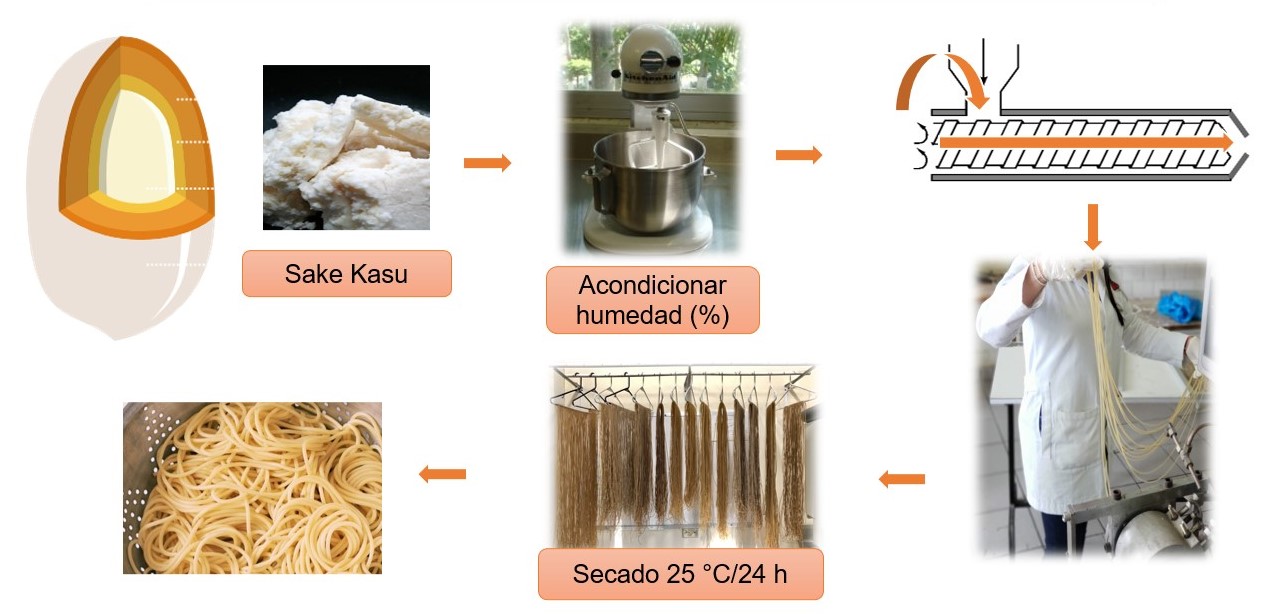Use of sake kasu for the production of gluten-free functional pasta: effect of the extrusion process on chemical, cooking and antioxidant properties.
DOI:
https://doi.org/10.18633/biotecnia.v27.2648Keywords:
sake lees, gluten-free rice pasta, bioactive compounds, process optimizationAbstract
Pasta made from broken rice and sake kasu is safe for people with celiac disease, as it is gluten-free by nature (due to the composition of its ingredients). The aim of this study was to study the effect of extrusion process on properties of gluten-free pastas made from broken rice and sake kasu to obtain optimal processing conditions. Effects of extrusion temperature (ET, 85-125°C), screw speed (SS, 75-125 rpm) and sake kasu flour conten (SKF, 25-75), on properties of pasta was evaluated, using a rotatable composite central design and the response surface methodology for the statistical analysis of the data. The protein content increases with the SKF increased. The cooking solids loss increased proportionally with SKF at high ET and high SS, demonstrating that at these extrusion conditions there is greater process severity. Total phenolic compounds content increased proportionally with SKF. The highest total antioxidant capacity (ABTS) was found at high SKF, medium ET, and high SS. The overall sensory acceptability response variable increased as ET and SS increased and decreased as SKF increased at low processing conditions. The optimum conditions were SKF = 60.83%, ET = 116.89 °C and SS = 107.93 rpm. The values of response variables under optimal conditions were: protein content of 13.18 ± 0.28%, cooking loss of 6.89 ± 0.36%, total phenolic compounds of 376.11 ± 18.55 mg GAE/100 g d.b., antioxidant activity (ABTS) of 8691.89 ± 381.13 µmol TE/100 g d.b. and general acceptability of 57.47 ± 1.80. Optimal paste obtained a higher protein content compared to commercial controls. Due to its composition and high sensory acceptability, sake kasu pasta prepared in present study has a potential beneficial effect on health. In addition, it can work as an alternative for people who cannot consume gluten and also look for products with a high protein content.
Downloads
References
AACC. 2000. Method 16-50. Approved methods of the American Association of Cereal Chemists (10th ed.). St. Paul, MN.
Adom, K. K., & Liu, R. H. 2002. Antioxidant activity of grains. Journal of Agricultural and Food Chemistry, 50(21), 6182–6187.
AOAC International. 2012. Official methods of analysis of AOAC International (19th ed.). Gaithersburg, MD.
Ashooriha, M., Ahmadi, R., Ahadi, H., & Emami, S. 2022. Application of kojic acid scaffold in the design of non-tyrosinase enzyme inhibitors. Chemical Biology & Drug Design. Advance online publication.
Bolarinwa, I. F., & Oyesiji, O. O. 2021. Gluten-free rice-soy pasta: Proximate composition, textural and sensory attributes. Heliyon, 7(1), e06052.
Box, G. E. P., & Behnken, D. W. 1960. Some new three-level designs for the study of quantitative variables. Technometrics, 2(4), 455–475.
Calvo-Lerma, J., Crespo-Escobar, P., Martínez-Barona, S., Fornés-Ferrer, V., & Donat, E. 2019. Dif-ferences in the macronutrient and dietary fibre profile of gluten-free products as compared to their gluten-containing counterparts. European Journal of Clinical Nutrition, 73(6), 930–936.
Cardello, A. V., & Schutz, H. G. 2004. Numerical scale point locations for constructing the LAM (labeled affective magnitude) scale. Journal of Sensory Studies, 19(4), 341–346.
Castro-Montoya, Y. A., Jacobo-Valenzuela, N., Delgado-Nieblas, C. I., Ruiz-Armenta, X. A., Heredia, J. B., Delgado-Murillo, S. A., & Zazueta-Morales, J. J. 2024. Effect of the extrusion process on phytochemical, antioxidant, and cooking properties of gluten-free pasta made from broken rice and nopal. Revista Mexicana de Ingeniería Química, 23(1), 2395–8472.
Codex Alimentarius. 2024. List of standards. Food and Agriculture Organization of the United Nations. https://www.fao.org/fao-who-codexalimentarius/codex-texts/list-standards/en/
Davis, P. J., & Williams, S. C. 1998. Protein modification by thermal processing. Allergy, 53(Suppl. 46), 102–105.
Delgado-Murillo, S. A., Castro-Montoya, Y. A., Zazueta-Morales, J. J., Quintero-Ramos, A., Ruiz-Armenta, X. A., Limón-Valenzuela, V., & Delgado-Nieblas, C. I. 2024. Effect of the extru-sion process on the physicochemical, phytochemical, and cooking properties of gluten-free pasta made from broken rice and chickpea flours. Journal of Biological and Health Sciences, 26, 12–121.
Delgado-Murillo, S. A., Zazueta-Morales, J. J., Quintero-Ramos, A., Castro-Montoya, Y. A., Ruiz-Armenta, X. A., Limón-Valenzuela, V., & Delgado-Nieblas, C. I. 2024. Effect of the extru-sion process on the physicochemical, phytochemical, and cooking properties of gluten-free pasta made from broken rice and chickpea flours. Biotecnia, 26, 112–121.
Fabila-Carrera, G. 1998. Design and analysis of industrial experiments (pp. 19–29). Universidad Iberoamericana.
Félix-Medina, J. V., Montes-Ávila, J., Reyes-Moreno, C., Perales-Sánchez, J. X. K., Gómez-Favela, M. A., Aguilar-Palazuelos, E., & Gutiérrez-Dorado, R. 2020. Second-generation snacks with high nutritional and antioxidant value produced by an optimized extrusion process from corn/common bean flours mixtures. LWT, 124, 109172.
García-Almeida, J., García-Alemán, J., Martínez-Alfaro, B., Vilchez López, F. J., & Maraver-Selfa, S. 2012. Celiac disease: Gluten-controlled diet. In Dietoterapia, nutrición clínica y metabolismo (16th ed.). Díaz de Santos.
Hatanaka, T., Uraji, M., Fujita, A., & Kawakami, K. 2015. Anti-oxidation activities of rice-derived peptides and their inhibitory effects on dipeptidylpeptidase-IV. International Journal of Peptide Research and Therapeutics, 21, 479–485.
Heimler, D., Vignolini, P., Dini, M. G., Vincieri, F. F., & Romani, A. 2006. Antiradical activity and polyphenol composition of local Brassicaceae edible varieties. Food Chemistry, 99(3), 464–469.
Ishak, N., Ahmad, F. B. L., Rosfarizan, M., Arbakariya, B. A., Mohd, S. M., Murni, H., & Helmi, W. 2018. Kinetics and optimization of lipophilic kojic acid derivative synthesis in polar aprotic solvent using lipozyme RMIM and its rheological study. Molecules, 23(2), 501.
Ito, K. R., Sato, T., Goto, H., Sato, K., Watanabe, J., & Yokoo, M. 2022. Utilization of sake lees as broiler feedstuff and its effects on growth performance and intestinal immunity. The Journal of Poultry Science, 59(3), 247–259.
Izu, H., Yamashita, S., Arima, H., & Fujii, T. 2019. Nutritional characterization of sake cake (sake-kasu) after heat-drying and freeze-drying. Bioscience, Biotechnology, and Biochemistry, 83(8), 1477–1483.
Jalgaonkar, K., Jha, S. K., Mahawar, M. K., & Yadav, D. N. 2019. Pearl millet-based pasta: Optimization of extrusion process through response surface methodology. Journal of Food Science and Tech-nology, 56(3), 1134–1144.
Marti, A., Seetharaman, K., & Pagani, M. A. 2010. Rice-based pasta: A comparison between conven-tional pasta-making and extrusion cooking. Journal of Cereal Science, 52(3), 404–409.
Martins, N., Barros, L., & Ferreira, I. C. F. R. 2016. In vivo antioxidant activity of phenolic compounds: Facts and gaps. Trends in Food Science & Technology, 48, 1–12.
Morreale, F., Boukid, F., Carini, E., Federici, E., Vittadini, E., & Pellegrini, N. 2019. Cooking quality and nutritional value of gluten-free pasta: An overview of the Italian market for 2015. International Journal of Food Science & Technology, 54(3), 780–786.
Myers, R. H., & Montgomery, D. C. 1995. Response surface methodology: Process and product opti-mization using designed experiments. Wiley.
Ola, A. R. B., Metboki, G., Lay, C. S., Sugi, Y., De Rozari, P., Darmakusuma, D., & Hakim, E. H. 2019. Single production of kojic acid by Aspergillus flavus and the revision of flufuran. Molecules, 24(23), 4200.
Ontiveros, N., Real-Delor, R. E., Mora-Melgem, J. A., Beltrán-Cárdenas, C. E., Figueroa-Salcido, O. G., Vergara-Jiménez, M. D. J., Cardenas-Torres, F. I., Flores-Mendoza, L. K., Arámburo-Gálvez, J. G., & Cabrera-Chávez, F. 2021. Prevalence of wheat/gluten-related disorders and gluten-free diet in Paraguay: An online survey-based study. Nutrients, 13(2), 396.
Padalino, L., Mastromatteo, M., Lecce, L., Spinelli, S., Conte, A., & Del Nobile, M. A. 2015. Optimi-zation and characterization of gluten-free spaghetti enriched with chickpea flour. International Journal of Food Sciences and Nutrition, 66(2), 148–158.
Rahman, M. J., Costa de Camargo, A., & Shahidi, F. 2017. Phenolic and polyphenolic profiles of chia seeds and their in vitro biological activities. Journal of Functional Foods, 35, 622–634.
Ramírez-Esparza, U., Ochoa-Reyes, E., Baeza-Jiménez, R., & Buenrostro-Figueroa, J. J. 2024. Effect of solid-state fermentation on total phenol content and antioxidant capacity of corn. CienciaUAT, 18(2), 136–144.
Sacchetti, G., Pinnavaia, G. G., Guidolin, E., & Dalla Rosa, M. 2004. Effects of extrusion temperature and feed composition on the functional, physical and sensory properties of chestnut and rice flour-based snack-like products. Food Research International, 37(5), 527–534.
Shakibaie, M., Ameri, A., Ghazanfari, R., Adeli-Sardou, M., Amirpour-Rostami, S., Torkzadeh-Mahani, M., Imanif, M., & Forootanfar, H. 2018. Statistical optimization of kojic acid production by a UV-induced mutant strain of Aspergillus terreus. Biotechnology and Industrial Microbiology, 4(9), 865–871.
Soriano-García, M., & Aguirre-Díaz, I. S. 2019. Nutritional functional value and therapeutic utilization of amaranth. In Nutritional value of amaranth. IntechOpen.
Trevisan, S., Pasini, G., & Simonato, B. 2019. An overview of expected glycaemic response of one ingredient commercial gluten-free pasta. LWT, 109, 13–16.
Tsutsui, N., Yamamoto, Y., & Iwami, K. 1998. Protein-nutritive assessment of sake lees obtained by brewing from liquefied rice. Journal of Nutritional Science and Vitaminology, 44(1), 177–186.
Yousif, N. E., & El Tinay, A. H. 2000. Effect of fermentation on protein fractions and in vitro protein digestibility of maize. Food Chemistry, 70(2), 181–184.
Zegarra, S., Muñoz, A. M., & Ramos-Escudero, F. 2019. Production of a gluten-free bread based on cañihua flour (Chenopodium pallidicaule Aellen) and evaluation of sensory acceptability. Chilean Journal of Nutrition, 46(5), 561–570.

Published
How to Cite
Issue
Section
License
Copyright (c) 2025

This work is licensed under a Creative Commons Attribution-NonCommercial-ShareAlike 4.0 International License.
The journal Biotecnia is licensed under the Attribution-NonCommercial-ShareAlike 4.0 International (CC BY-NC-SA 4.0) license.
















_(2).jpg)







